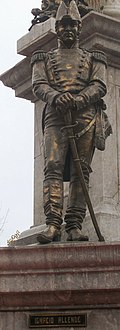Ignacio Allende
Ignacio Allende | |
|---|---|
| Died | June 26, 1811 (aged 42) Chihuahua, Nueva Vizcaya, Viceroyalty of New Spain (now Chihuahua, Mexico) |
| Allegiance | |
| Years of service | 1802 - 1811 |
| Rank | Captain (New Spain), Lieutenant General (Mexican independence movement) |
| Battles/wars | Mexican War of Independence |
Ignacio José de Allende y Unzaga (US: /ɑːˈjɛndeɪ, -di/,[1][2] UK: /æˈ-, aɪˈɛn-/,[3][4] Spanish: [iɣˈnasjo aˈʝende]; January 21, 1769 – June 26, 1811), commonly known as Ignacio Allende, was a captain of the Spanish Army in New Spain who came to sympathize with the Mexican independence movement. He attended the secret meetings organized by Josefa Ortiz de Domínguez, where the possibility of an independent Mexico was discussed. He fought along with Miguel Hidalgo y Costilla in the first stage of the struggle, eventually succeeding him in leadership of the rebellion. Allende was captured by Spanish colonial authorities while he was in Coahuila and executed for treason in Chihuahua.
Biography


Allende was born on January 21, 1769, to a wealthy Spanish
In 1802, he joined the army, serving under general
Originally, the independence movement was to be led jointly by Allende and Aldama. A change of plans prompted by the discovery of the conspiracy forced Hidalgo to start the rebellion earlier than agreed. The "
Allende was taken to the city of
Legacy
Allende is a national
See also
References
- ^ "Allende". Collins English Dictionary. HarperCollins. Retrieved 27 July 2019.
- ^ "Allende Gossens". Merriam-Webster.com Dictionary. Retrieved 27 July 2019.
- ^ "Allende, Salvador". Lexico UK English Dictionary. Oxford University Press. Archived from the original on 2021-08-07.
- ^ "Allende, Isabel". Longman Dictionary of Contemporary English. Longman. Retrieved 20 August 2019.
- ^ "Miguel Hidalgo y Costilla". Mexico Desconocido (in Spanish). Mexico City: Grupo Editorial Impresiones Aéreas. Archived from the original on November 21, 2008. Retrieved November 27, 2008.
- ^ "¿Quien fue Hidalgo?" (in Spanish). Mexico: INAH. Archived from the original on September 21, 2008. Retrieved November 27, 2009.
External links
- (in Spanish) Account of the Grito de Dolores, by Ignacio Allende
